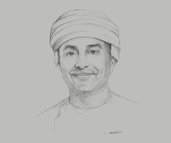Waleed Al Hashar, CEO, Bank Muscat : Interview

Interview : Waleed Al Hashar
To what extent will the Central Bank of Oman (CBO) relax lending ratio requirements in order to reinvigorate the domestic interbank market?
WALEED AL HASHAR: The CBO has adopted an accommodative monetary policy, along with other regulatory policies, to support growth in the economy. The CBO has taken a number of steps to help commercial banks and financial institutions achieve credit growth. These steps have ensured adequate liquidity and credit availability in the system to support productive activities. The CBO has reduced the minimum capital adequacy ratio from 12% to 11%, helping to increase banks’ lending capacity. The CBO has also relaxed lending ratios, allowing banks to include their net domestic interbank borrowings as part of their deposit base. This has created more space for credit expansion, encouraging banks to borrow and lend to each other, leading to the activation of the local interbank market and optimal utilisation of liquidity. The CBO has also withdrawn the minimum 100% risk-weighted requirement on exposures to other sovereigns and central banks. The move has led to greater operational flexibility for efficient Treasury operations, liquidity management and sound correspondent bank relationships. The banks are mandated to implement the liquidity coverage ratio to ensure that they have sufficient high quality liquid assets to survive a stress scenario. With all these initiatives, the CBO has ensured that the banks are resilient and adequately capitalised.
How has the project finance market developed in Oman, and what are the most significant trends for financing large-scale projects?
AL HASHAR: The project finance market has witnessed significant trends in recent years owing to market developments. Low oil prices from 2015-17 drove many governments in the region to vigorously pursue economic diversification strategies, shifting their focus to public-private partnership (PPP) contracts as a means to deliver major projects. In Oman, as many as 112 development projects in different sectors have been identified by the government as part of Tanfeedh, the National Programme for Enhancing Economic Diversification, to be funded on a PPP basis. Therefore, we see PPP-based project financing as a significant emerging and sustainable trend in the GCC region in general and Oman in particular. Regional governments are looking to achieve better cost efficiencies through the consolidation of state-owned companies. This has resulted in improved efficiencies of government-owned entities. Consolidation of government-owned enterprises has emerged as a key trend in the project financing space.
Export Credit Agency (ECA) financing is also becoming a dominant theme in the Middle East. In Oman, major project finance transactions in various sectors have ECA components in financing. This has resulted in lower effective borrowing costs for these projects. The rise of renewable energy in the energy mix is another emerging trend in the region. Therefore, renewable energy financing is a key trend in the project finance space. Additionally, financial institutions and corporates are continuing to tap debt markets, so project bonds are another emerging trend in project finance.
How will bancassurance tie-ups assist in facilitating insurance penetration in Oman?
AL HASHAR: The financial service industry is undergoing tremendous transformation on the back of technological advancements like digitalisation. Banks are at the forefront of this innovation and insurers can leverage on this platform through Bancassurance tie-ups. Historically, insurers face challenges as the engagement level of customers with insurance companies is very minimal. But customers tend to have more interactions with banks, and insurers can leverage this through bancassurance tie-ups. Moreover, the distribution networks of banks in Oman are strong, and insurance penetration has the potential to grow significantly by establishing a relationship with banks.
You have reached the limit of premium articles you can view for free.
Choose from the options below to purchase print or digital editions of our Reports. You can also purchase a website subscription giving you unlimited access to all of our Reports online for 12 months.
If you have already purchased this Report or have a website subscription, please login to continue.

